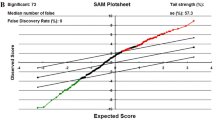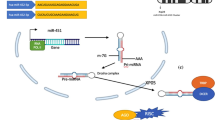Abstract
MicroRNAs are non-coding RNAs with important functions in several biological processes, such as, regulation of cell cycle, immune response, inflammation, and apoptosis. In fact, deregulation and abnormal expression of these molecules is associated with human pathologies including cancer and several have already emerged as potential prognostic biomarkers in different neoplasias. miR-34a is directly regulated by p53 and acts as tumor suppressor while miR-125b plays a significant role in immune response and apoptosis. In cervical carcinogenesis, HPV proteins seem to interact with both miR-34a and miR-125b changing its expression and promoting persistent infection and cervical cancer development. In this review we describe the potential role of miR-125b and miR-34a in cervical carcinogenesis, including interaction with HPV and mechanism of deregulation. Additionally, their clinical applications in cervical cancer as prognostic/predictive biomarkers are also briefly discussed.

Similar content being viewed by others
References
Jemal A et al (2011) Global cancer statistics. CA Cancer J Clin 61(2):69–90
Sankaranarayanan R, Ferlay J (2006) Worldwide burden of gynaecological cancer: the size of the problem. Best Pract Res Clin Obstet Gynaecol 20(2):207–225
Frazer IH (2004) Prevention of cervical cancer through papillomavirus vaccination. Nat Rev Immunol 4(1):46–54
Franco EL (2009) A new generation of studies of human papillomavirus DNA testing in cervical cancer screening. J Natl Cancer Inst 101(23):1600–1601
Zur Hausen H (2009) The search for infectious causes of human cancers: where and why. Virology 392(1):1–10
Ramanakumar AV et al (2010) Human papillomavirus (HPV) types 16, 18, 31, 45 DNA loads and HPV-16 integration in persistent and transient infections in young women. BMC Infect Dis 10:326
Hwang SJ, Shroyer KR (2012) Biomarkers of cervical dysplasia and carcinoma. J Oncol 2012:507286
Woodman CB, Collins SI, Young LS (2007) The natural history of cervical HPV infection: unresolved issues. Nat Rev Cancer 7(1):11–22
Sousa H et al (2007) Is the p53 codon 72 polymorphism a key biomarker for cervical cancer development? A meta-analysis review within European populations. Int J Mol Med 20(5):731–741
Lee RC, Feinbaum RL, Ambros V (1993) The C. elegans heterochronic gene lin-4 encodes small RNAs with antisense complementarity to lin-14. Cell 75(5):843–854
Malumbres M (2012) miRNAs versus oncogenes: the power of social networking. Mol Syst Biol 8:569
Lagos-Quintana M et al (2001) Identification of novel genes coding for small expressed RNAs. Science 294(5543):853–858
Lau NC et al (2001) An abundant class of tiny RNAs with probable regulatory roles in Caenorhabditis elegans. Science 294(5543):858–862
Lujambio A, Lowe SW (2012) The microcosmos of cancer. Nature 482(7385):347–355
Bartel DP (2004) MicroRNAs: genomics, biogenesis, mechanism, and function. Cell 116(2):281–297
Wightman B, Ha I, Ruvkun G (1993) Posttranscriptional regulation of the heterochronic gene lin-14 by lin-4 mediates temporal pattern formation in C. elegans. Cell 75(5):855–862
Melo SA, Esteller M (2011) Dysregulation of microRNAs in cancer: playing with fire. FEBS Lett 585(13):2087–2099
Kong YW et al (2012) microRNAs in cancer management. Lancet Oncol 13(6):e249–e258
Pritchard CC, Cheng HH, Tewari M (2012) MicroRNA profiling: approaches and considerations. Nat Rev Genet 13(5):358–369
Tili E et al (2008) MicroRNAs, the immune system and rheumatic disease. Nat Clin Pract Rheumatol 4(10):534–541
Wang N et al (2009) Role of microRNAs in cardiac hypertrophy and heart failure. IUBMB Life 61(6):566–571
Lu J et al (2005) MicroRNA expression profiles classify human cancers. Nature 435(7043):834–838
Hermeking H (2012) MicroRNAs in the p53 network: micromanagement of tumour suppression. Nat Rev Cancer 12(9):613–626
Pereira PM et al (2010) MicroRNA expression variability in human cervical tissues. PLoS One 5(7):e11780
He L et al (2007) A microRNA component of the p53 tumour suppressor network. Nature 447(7148):1130–1134
He X, He L, Hannon GJ (2007) The guardian’s little helper: microRNAs in the p53 tumor suppressor network. Cancer Res 67(23):11099–11101
Martinez I et al (2008) Human papillomavirus type 16 reduces the expression of microRNA-218 in cervical carcinoma cells. Oncogene 27(18):2575–2582
Nambaru L et al (2009) Prognostic significance of HPV physical status and integration sites in cervical cancer. Asian Pac J Cancer Prev 10(3):355–360
Wang X et al (2008) Aberrant expression of oncogenic and tumor-suppressive microRNAs in cervical cancer is required for cancer cell growth. PLoS One 3(7):e2557
Li BH et al (2011) Reduced miR-100 expression in cervical cancer and precursors and its carcinogenic effect through targeting PLK1 protein. Eur J Cancer 47(14):2166–2174
Li Y et al (2011) Progressive miRNA expression profiles in cervical carcinogenesis and identification of HPV-related target genes for miR-29. J Pathol 224(4):484–495
Greco D et al (2011) Human papillomavirus 16 E5 modulates the expression of host microRNAs. PLoS One 6(7):e21646
O’Connell RM, Zhao JL, Rao DS (2011) MicroRNA function in myeloid biology. Blood 118(11):2960–2969
Jia HY et al (2012) MicroRNA-125b functions as a tumor suppressor in hepatocellular carcinoma cells. Int J Mol Sci 13(7):8762–8774
Le MT et al (2009) MicroRNA-125b is a novel negative regulator of p53. Genes Dev 23(7):862–876
Zhang Y et al (2011) miR-125b is methylated and functions as a tumor suppressor by regulating the ETS1 proto-oncogene in human invasive breast cancer. Cancer Res 71(10):3552–3562
Chaudhuri AA et al (2012) Oncomir miR-125b regulates hematopoiesis by targeting the gene Lin28A. Proc Natl Acad Sci USA 109(11):4233–4238
Zhao A et al (2012) MicroRNA-125b induces cancer cell apoptosis through suppression of Bcl-2 expression. J Genet Genomics 39(1):29–35
Pang Y, Young CY, Yuan H (2010) MicroRNAs and prostate cancer. Acta Biochim Biophys Sin (Shanghai) 42(6):363–369
Visone R et al (2007) Specific microRNAs are downregulated in human thyroid anaplastic carcinomas. Oncogene 26(54):7590–7595
Zhou M et al (2010) MicroRNA-125b confers the resistance of breast cancer cells to paclitaxel through suppression of pro-apoptotic Bcl-2 antagonist killer 1 (Bak1) expression. J Biol Chem 285(28):21496–21507
Gong J et al (2013) MicroRNA-125b promotes apoptosis by regulating the expression of Mcl-1, Bcl-w and IL-6R. Oncogene 32(25):3071–3079
Scott GK et al (2007) Coordinate suppression of ERBB2 and ERBB3 by enforced expression of micro-RNA miR-125a or miR-125b. J Biol Chem 282(2):1479–1486
Nicolete LD et al (2012) Upregulation of hsa-miR-125b in HTLV-1 asymptomatic carriers and HTLV-1-associated myelopathy/tropical spastic paraparesis patients. Mem Inst Oswaldo Cruz 107(6):824–827
Witwer KW et al (2012) Relationships of PBMC microRNA expression, plasma viral load, and CD4+ T-cell count in HIV-1-infected elite suppressors and viremic patients. Retrovirology 9:5
Nuovo GJ et al (2010) Strong inverse correlation between microRNA-125b and human papillomavirus DNA in productive infection. Diagn Mol Pathol 19(3):135–143
Bommer GT et al (2007) p53-mediated activation of miRNA34 candidate tumor-suppressor genes. Curr Biol 17(15):1298–1307
Chang TC et al (2007) Transactivation of miR-34a by p53 broadly influences gene expression and promotes apoptosis. Mol Cell 26(5):745–752
Corney DC et al (2007) MicroRNA-34b and microRNA-34c are targets of p53 and cooperate in control of cell proliferation and adhesion-independent growth. Cancer Res 67(18):8433–8438
Tanaka N et al (2012) Frequent methylation and oncogenic role of microRNA-34b/c in small-cell lung cancer. Lung Cancer 76(1):32–38
Corney DC et al (2010) Frequent downregulation of miR-34 family in human ovarian cancers. Clin Cancer Res 16(4):1119–1128
Vogt M et al (2011) Frequent concomitant inactivation of miR-34a and miR-34b/c by CpG methylation in colorectal, pancreatic, mammary, ovarian, urothelial, and renal cell carcinomas and soft tissue sarcomas. Virchows Arch 458(3):313–322
Wang X et al (2009) Oncogenic HPV infection interrupts the expression of tumor-suppressive miR-34a through viral oncoprotein E6. RNA 15(4):637–647
Li B et al (2010) Reduced miR-34a expression in normal cervical tissues and cervical lesions with high-risk human papillomavirus infection. Int J Gynecol Cancer 20(4):597–604
Johnson CD et al (2007) The let-7 microRNA represses cell proliferation pathways in human cells. Cancer Res 67(16):7713–7722
Akao Y, Nakagawa Y, Naoe T (2006) let-7 microRNA functions as a potential growth suppressor in human colon cancer cells. Biol Pharm Bull 29(5):903–906
Tan HX et al (2010) MicroRNA-9 reduces cell invasion and E-cadherin secretion in SK-Hep-1 cell. Med Oncol 27(3):654–660
Cimmino A et al (2005) miR-15 and miR-16 induce apoptosis by targeting BCL2. Proc Natl Acad Sci USA 102(39):13944–13949
Guo CJ et al (2009) miR-15b and miR-16 are implicated in activation of the rat hepatic stellate cell: an essential role for apoptosis. J Hepatol 50(4):766–778
Song L et al (2011) miR-18a impairs DNA damage response through downregulation of ataxia telangiectasia mutated (ATM) kinase. PLoS One 6(9):e25454
Zhong Z et al (2012) miR-21 induces cell cycle at S phase and modulates cell proliferation by down-regulating hMSH2 in lung cancer. J Cancer Res Clin Oncol 138(10):1781–1788
Jin Y (2011) 3,3′-Diindolylmethane inhibits breast cancer cell growth via miR-21-mediated Cdc25A degradation. Mol Cell Biochem 358(1–2):345–354
Si ML et al (2007) miR-21-mediated tumor growth. Oncogene 26(19):2799–2803
Silber J et al (2008) miR-124 and miR-137 inhibit proliferation of glioblastoma multiforme cells and induce differentiation of brain tumor stem cells. BMC Med 6:14
Kozaki K et al (2008) Exploration of tumor-suppressive microRNAs silenced by DNA hypermethylation in oral cancer. Cancer Res 68(7):2094–2105
Bhaumik D et al (2008) Expression of microRNA-146 suppresses NF-kappaB activity with reduction of metastatic potential in breast cancer cells. Oncogene 27(42):5643–5647
Piovan C et al (2012) Oncosuppressive role of p53-induced miR-205 in triple negative breast cancer. Mol Oncol 6(4):458–472
Kim YK et al (2009) Functional links between clustered microRNAs: suppression of cell-cycle inhibitors by microRNA clusters in gastric cancer. Nucleic Acids Res 37(5):1672–1681
Hu H, Gatti RA (2011) MicroRNAs: new players in the DNA damage response. J Mol Cell Biol 3(3):151–158
Hu W et al (2010) Negative regulation of tumor suppressor p53 by microRNA miR-504. Mol Cell 38(5):689–699
Author information
Authors and Affiliations
Corresponding author
Rights and permissions
About this article
Cite this article
Ribeiro, J., Sousa, H. MicroRNAs as biomarkers of cervical cancer development: a literature review on miR-125b and miR-34a. Mol Biol Rep 41, 1525–1531 (2014). https://doi.org/10.1007/s11033-013-2998-0
Received:
Accepted:
Published:
Issue Date:
DOI: https://doi.org/10.1007/s11033-013-2998-0




